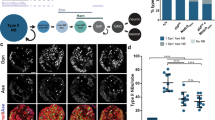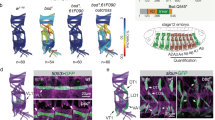Abstract
We have examined the process by which cell diversity is generated in neuroblast (NB) lineages in the central nervous system of Drosophila melanogaster. Thoracic NB6-4 (NB6-4t) generates both neurons and glial cells, whereas NB6-4a generates only glial cells in abdominal segments1. This is attributed to an asymmetric first division of NB6-4t, localizing prospero (pros) and glial cell missing (gcm) only to the glial precursor cell, and a symmetric division of NB6-4a, where both daughter cells express pros and gcm2,3,4,5. Here we show that the NB6-4t lineage represents the ground state, which does not require the input of any homeotic gene, whereas the NB6-4a lineage is specified by the homeotic genes abd-A and Abd-B. They specify the NB6-4a lineage by down-regulating levels of the G1 cyclin, DmCycE (CycE). CycE, which is asymmetrically expressed after the first division of NB6-4t, functions upstream of pros and gcm to specify the neuronal sublineage. Loss of CycE function causes homeotic transformation of NB6-4t to NB6-4a, whereas ectopic CycE induces reverse transformations. However, other components of the cell cycle seem to have a minor role in this process, suggesting a critical role for CycE in regulating cell fate in segment-specific neural lineages.
This is a preview of subscription content, access via your institution
Access options
Subscribe to this journal
Receive 12 print issues and online access
$209.00 per year
only $17.42 per issue
Buy this article
- Purchase on Springer Link
- Instant access to full article PDF
Prices may be subject to local taxes which are calculated during checkout





Similar content being viewed by others
References
Schmidt, H. et al. The embryonic central nervous system lineages of Drosophila melanogaster. II. Neuroblast lineages derived from the dorsal part of the neuroectoderm. Dev. Biol. 189, 186–204 (1997).
Akiyama-Oda, Y., Hotta, Y., Tsukita, S. & Oda, H. Mechanism of glia–neuron cell-fate switch in the Drosophila thoracic neuroblast 6-4 lineage. Development 127, 3513–3522 (2000).
Akiyama-Oda, Y., Hotta, Y., Tsukita, S. & Oda, H. Distinct mechanisms triggering glial differentiation in Drosophila thoracic and abdominal neuroblasts 6-4. Dev. Biol. 222, 429–439 (2000).
Bernardoni, R., Kammerer, M., Vonesch, J. L. & Giangrande, A. Gliogenesis depends on glide/gcm through asymmetric division of neuroglioblasts. Dev. Biol. 216, 265–275 (1999).
Freeman, M. R. & Doe, C. Q. Asymmetric Prospero localization is required to generate mixed neuronal/glial lineages in the Drosophila CNS. Development 128, 4103–4112 (2001).
Doe, C. Q. in Determinants of Neuronal Identity (eds Macagno, E. R. & Shankland, M.) 119–154 (Academic, New York, 1992).
Bossing, T., Udolph, G., Doe, C. Q. & Technau, G. M. The embryonic central nervous system lineages of Drosophila melanogaster. I. Neuroblast lineages derived from the ventral half of the neuroectoderm. Dev. Biol. 179, 41–64 (1996).
Bhat, K. M. Segment polarity genes in neuroblast formation and identity specification during Drosophila neurogenesis. Bioessays 21, 472–485 (1999).
Skeath, J. B. At the nexus between pattern formation and cell-type specification: the generation of individual neuroblast fates in the Drosophila embryonic central nervous system. Bioessays 21, 922–931 (1999).
Carroll, S. B., Weatherbee, S. D. & Langeland, J. A. Homeotic genes and the regulation and evolution of insect wing number. Nature 375, 58–61 (1995).
Lewis, E. B. A gene complex controlling segmentation in Drosophila. Nature 276, 565–570 (1978).
Struhl, G. & Brower, D. Early role of the esc+ gene product in the determination of segments in Drosophila. Cell 31, 285–292 (1982).
Koff, A. et al. Formation and activation of a cyclin E–cdk2 complex during the G1 phase of the human cell cycle. Science 257, 1689–1694 (1992).
Richardson, H. E., O´ Keefe, L. V., Reed, S. I. & Saint, R. A Drosophila G1-specific cyclin E homolog exhibits different modes of expression during embryogenesis. Development 119, 673–690 (1993).
Prokop, A. & Technau, G. M. in Cellular Interactions in Development (ed. Hartley, D. A.) 33–58 (IRL, Oxford, 1993).
de Nooij, J. C., Letendre, M. A. & Hariharan, I. K. A cyclin-dependent kinase inhibitor, Dacapo, is necessary for timely exit from the cell cycle during Drosophila embryogenesis. Cell 87, 1237–1247 (1996).
Lane, M. E. et al. Dacapo, a cyclin-dependent kinase inhibitor, stops cell proliferation during Drosophila development. Cell 87, 1225–1235 (1996).
de Nooij, J. C. & Hariharan, I. K. Uncoupling cell fate determination from patterned cell division in the Drosophila eye. Science 270, 983–985 (1995).
Harper, W. J., Adami, G. R., Wei, N., Keyomarsi, K. & Elledge, S. J. The p21 Cdk-interacting protein Cip1 is a potent inhibitor of G1 cyclin-dependent kinases. Cell 75, 805–816 (1993).
Duronio, R. J., O'Farrell, P. H., Xie, E. J., Brook, A. & Dyson, N. The transcription factor E2F is required for S phase during Drosophila embryogenesis. Genes Dev. 9, 1445–1455 (1995).
Duronio, R. J. & O'Farrell, P. H. Developmental control of the G1 to S transition in Drosophila: cyclin E is a limiting downstream target of E2F. Genes Dev. 9, 1456–1468 (1995).
Du, W. & Dyson, N. The role of RBF in the introduction of G1 regulation during Drosophila embryogenesis. EMBO J. 18, 916–925 (1999).
Hayashi, S. A Cdc2 dependent checkpoint maintains diploidy in Drosophila. Development 122, 1051–1058 (1996).
Tio, M., Udolph, G., Yang, X. & Chia, W. cdc2 links the Drosophila cell cycle and asymmetric division machineries. Nature 409, 1063–1067 (2001).
Manak, J. R., Mathies, L. D. & Scott, M. P. Regulation of a decapentaplegic midgut enhancer by homeotic proteins. Development 120, 3605–3619 (1994).
Ekker, S. C., Young, K. E., von Kessler, D. P. & Beachy, P. A. Optimal DNA sequence recognition by the Ultrabithorax homeodomain of Drosophila. EMBO J. 10, 1179–1186 (1991).
Jones, L., Richardson, H. & Saint, R. Tissue-specific regulation of cyclin E transcription during Drosophila melanogaster embryogenesis. Development 127, 4619–4630 (2000).
Ohnuma, S., Philpott, A., Wang, K., Holt, C. E. & Harris, W. A. p27Xic1, a Cdk inhibitor, promotes the determination of glia cells in Xenopus retina. Cell 99, 499–510 (1999).
Brand, A. H. & Perrimon, N. Targeted gene expression as a means of altering cell fates and generating dominant phenotypes. Development 118, 401–415 (1993).
Campos-Ortega, J. A. & Hartenstein, V. The embryonic development of Drosophila melanogaster. (Springer Verlag, Berlin, 1997).
Acknowledgements
We thank J. Urban, C. Lehner and A. Rogulja-Ortmann for comments; G. Vogler and O. Vef for advice on methods; and C. Lehner, I. Duncan, M. Freeman, C.Q. Doe, A. Michelson, E. Sanchez-Herrero, the Developmental Studies Hybridoma Bank (DSHB) and the Bloomington stock center for fly strains, antibodies and cDNA clones. We thank members of both of our laboratories for technical help and advice. This work was supported by the Deutsche Forschungs-gemeinschaft (grant to G.M.T.) and the Volkswagen-Stiftung (grant to L.S.S. and G.M.T.)
Author information
Authors and Affiliations
Corresponding authors
Ethics declarations
Competing interests
The authors declare no competing financial interests.
Supplementary information
Supplementary Information
Fig S1 (PDF 182 kb)
Rights and permissions
About this article
Cite this article
Berger, C., Pallavi, S., Prasad, M. et al. A critical role for Cyclin E in cell fate determination in the central nervous system of Drosophila melanogaster. Nat Cell Biol 7, 56–62 (2005). https://doi.org/10.1038/ncb1203
Received:
Accepted:
Published:
Issue Date:
DOI: https://doi.org/10.1038/ncb1203
This article is cited by
-
Cell cycle reentry from the late S phase: implications from stem cell formation in the moss Physcomitrella patens
Journal of Plant Research (2015)
-
Genome-level identification of targets of Hox protein Ultrabithorax in Drosophila: novel mechanisms for target selection
Scientific Reports (2011)
-
Cyclin D1 fine-tunes the neurogenic output of embryonic retinal progenitor cells
Neural Development (2009)
-
Sequence conservation and combinatorial complexity of Drosophila neural precursor cell enhancers
BMC Genomics (2008)
-
Maintenance of motor neuron progenitors in Xenopus requires a novel localized cyclin
EMBO reports (2007)



